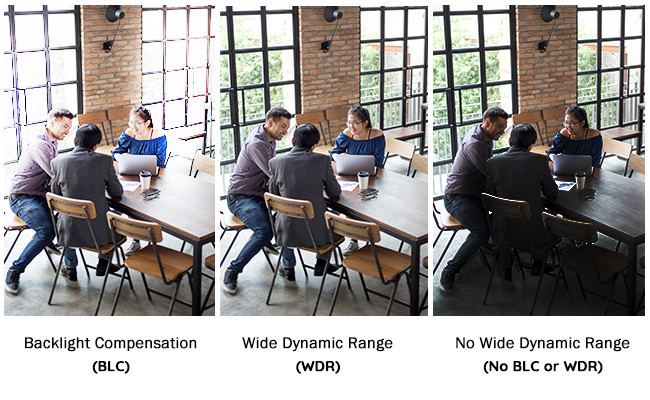What’s WDR, BLC or HLC in CCTV/IP Cameras

Very often, we saw part of an image taken by CCTV/IP security cameras extremely dark but another part is very bright so much so that you can’t see any detail.
The question now is how could we do about it?
Here is how technologies like wide dynamic range (WDR), backlight compensation (BLC), highlight compensation (HLC) come into play in image quality.
WDR, BLC, and HLC technologies enable CCTV/IP security cameras to capture clear and balanced images/videos even in some challenging light conditions.
WDR vs BLC vs HLC
Wide dynamic range, backlight compensation, and highlight compensation technology differ from one from another mainly in how do they work to help security cameras capture clear images/videos with balanced lighting? How do they apply in different scenarios?
What is WDR, BLC or HLC in CCTV/IP Cameras
To understand their differences, it's important to know what WDR, BLC, and HLC are in CCTV/IP Cameras and how such technology uses to affect how the images/videos captured by CCTV/IP cameras look like day or night.
Wide dynamic range (WDR) technology balances the light on an image via image sensors (CCD & COMS) and digital signal processor (DSP). A CCTV/IP camera with WDR capability comes with an image sensor that packed with two image sensors of the Charge Coupled Device (CCD) type that capture one scene for multiple times and combine those captures to optimize overall videos/images quality.
There are two types of wide dynamic range (WDR) technologies used in CCTV/IP cameras: Digital WDR & True WDR. Digital WDR surveillance cameras use software algorithms to brighten dark areas and dim overly-lit areas in images while true WDR deploys light-sensitive sensors (CCD/CMOS) and DSP technology to balance lighting.
Backlight compensation (BLC) works by increasing the level of exposure for the entire image via digital signal processors (DSP), which divides an image or scene into different sections and adjust the lighting accordingly.
Simply put, BLC works to brighten the whole scene on a video/image frame instead of balancing lights on overexposed and underexposed areas like WDR does, which in some cases, wash out some already overly-lit areas in an image/video.
Highlight compensation (HLC) is a technology used in CCTV/IP security cameras to deal with image overexposed with lights like headlights or spotlights. Security cameras’ image sensors detect strong lights in video and reduce exposure on these spots to enhance the overall quality.
How Does WDR, BLC, or HLC Technology Perform in Different Scenarios
WDR technology is widely used in many high-quality CCTV/IP surveillance cameras.
True WDR security cameras capture exceptionally balanced images/videos in many environments with a sharp contrast of lighting, for example, a dark parking lot with excessive sunlight at the entrance. WDR is inherently better than BLC technology in capturing a scene with challenging lighting conditions.
For example, Reolink RLC-423 PTZ IP security camera does well in challenging lighting conditions and capture crisp videos thanks to the digital WDR technology.
PoE Waterproof PTZ Security Camera
5-Megapixel Super HD; 360° Pan & 90° Tilt ; 4X Optical Zoom; 190ft Infrared Night Vision; Smart Motion Detection; Remote Live View & Control.
BLC technology has been used in CCTV/IP security camera with CCD image sensor to increase exposure for a whole scene, which performs better in a poorly-lit area or monitors areas without enough illumination such as the backyard, alley, which makes Reolink RLC-410 outdoor camera an excellent choice for monitoring poorly-lit areas.
PoE Bullet IP Security Camera with Audio
5MP/4MP Super HD; Outdoor/Indoor Protection; 100ft Infrared Night Vision; Audio Recording; Mobile Remote Access & Control.
Even better, Reolink Argus 2, the color night vision security camera, combines digital WDR and BLC technology, which is also great for monitoring areas with low illuminations. Here is an example of how Reolink Argus 2 performs at night.
Highlight compensation (HLC) technology is normally used to reduce exposure from a strong light like a spotlight on an image/video, commonly seen on CCTV traffic surveillance system, highway or traffic monitoring.
WDR vs BLC vs HLC, Which One is Better
In general, wide dynamic range security cameras balance lighting better and provide better quality videos/images than backlight compensation (BLC) security cameras.

DB is the value to measure the wide dynamic range. Higher and improved WDR range dome CCTV /IP security cameras, such as 120DB, is able to produce a wider range of lighting, allowing them to balance lightings on areas overexposed or underexposed with lights, even at night.
CCTV/IP cameras packed with WDR and BLC are capable of capture clear and balanced images/videos in various contexts. Digital WDR, which is cheaper than true WDR, is also used in many security cameras to enhance image quality, which also works fine even at night.
Conclusion
Technologies like WDR, BLC or HLC were invented to help security cameras to produce clear images/videos even in different light condition.
It’s important to know the difference and consider these technologies when choosing security cameras.
Despite the advancement in CCTV/IP surveillance cameras, it's still advised not to point the camera directly to some strong light sources for a long period of time such as the sunlight, headlight, or spotlight. And when installing security cameras, users should adjust pointing angle to avoid pointing directly to lights or other reflective bodies.
Search
Be in the Know
Security insights & offers right into your inbox


